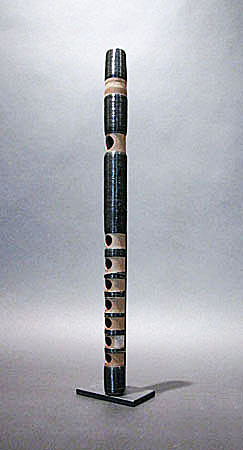
Owner: HWMC
Catalogue #: AS-AEBH-12-14
Provenance: Flutist Georges Barrère
Edge-blown Flutes
Japan 'Ryūteki' (Flute)
Japan
Japanese
Bamboo, lacquer, paint, bark
Late 19th century
Length: 15.75; Inner diameter: 0.5 in
Aerophones – Wind Instruments Proper – Edge-blown Flutes
The ryūteki (literally “dragon flute”) is a Japanese transverse flute (fue) made of bamboo. It has seven finger holes in the front and the interior is coated with tempera paint, used to preserve, and keep it from cracking. It is also bound on the outside with thin lacquered strips of twisted cherry bark (kabamaki). This keyless cylindrical bore tube has a weighted plug inserted at the end above the embouchure hole. When playing the ryūteki, the holes are covered not by the fingertips, but with the fleshy part of the fingers. This allows for better control of ‘half-holing, a technique used for chromatic notes.
The ryūteki is used in gagaku (Shinto classical music associated with Japan’s imperial court). The sound of the ryūteki is said to represent the dragons which ascend the skies between the heavenly lights (represented by the shō) and the people of the earth (represented by the hichiriki). Both the shō and the hichiriki can be found in this collection.
The ryūteki closely resembles the nokan, especially from the outer appearance, the bark wrapping, the lacquered bore, and the internal metal weight above the embouchure. Unlike the nokan, the ryūteki has a more circular embouchure hole, is cylindrical, and does not have a short tube inserted in the bore between the embouchure-hole and the nearest finger hole.
